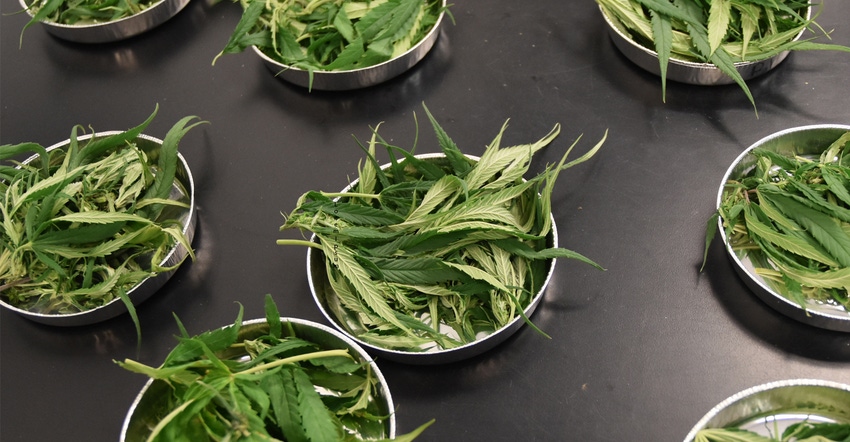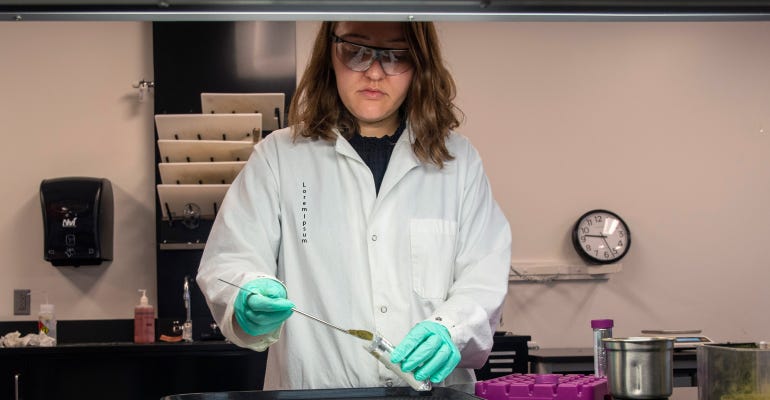September 24, 2019

Researchers at Kansas State University's Olathe campus are helping Kansas hemp growers clear the smoke when it comes to knowing the levels of delta-9 THC and CBD concentrations in their industrial hemp crop.
Now, growers can voluntarily send samples of their hemp crop to the Postharvest Physiology Lab at K-State Olathe to get the samples analyzed and quantified for five hemp-based cannabinoids, including delta-9 HTC and CBD. Results are confidential and given to growers three to five business days after receiving a plant sample.
The Postharvest Physiology Lab is directed by Eleni Pliakoni, associate professor of urban food production and postharvest handling. It is the only state-licensed testing facility in Kansas outside of the Kansas Department of Agriculture.
The K-State Olathe lab uses the same testing methods as the state Agriculture Department, and the lab received a State Educational Institution License from the agriculture department as part of the 2019 Kansas Industrial Hemp Research Program.
"We've been working closely with the KDA chemists to make sure that our testing methods are identical so that it's a beneficial service to growers," Pliakoni said. "We help growers check their crop's THC levels before the regulatory testing is done by the KDA. We also are providing growers with their crop's CBD levels, which will help them better market their product."
Many uses for hemp
Hemp can be used to create fabric, paper, biofuel, plastics, health foods, cosmetics, building materials and more.
Changes to the 2018 Farm Bill made it possible for Kansas and 41 other states to grow hemp as an alternative industrial crop. Kansas made 2019 its pilot year for small-scale hemp production and is vying to be America's capital for hemp production. Missouri will allow limited hemp farming in 2020.
Hemp is a variety of cannabis and as such, it has chemical compounds called cannabinoids. Some cannabinoids contain psychoactive ingredients, such as delta-9 THC, that affect the mind and behavior. Other cannabinoids, such as CBD, contain health benefits.
 PROCESSING: Tricia Jenkins and Joseph Rundquist, both master's students in the Postharvest Physiology Lab, add the powdered hemp to a solution so it can be analyzed by an ultra-high-pressure liquid chromatography machine.
PROCESSING: Tricia Jenkins and Joseph Rundquist, both master's students in the Postharvest Physiology Lab, add the powdered hemp to a solution so it can be analyzed by an ultra-high-pressure liquid chromatography machine.

Delta-9 THC levels in hemp are significantly lower than those in marijuana. The delta-9 THC levels of hemp can rise though if the plant becomes stressed by dry conditions, wind or other weather events. Because of this, KDA requires that testing be done on every hemp crop to ensure that delta-9 THC levels are not above the legal limit of 0.3%.
Researchers are measuring the levels of CBD, CBDA, CBN, delta-9 THC and delta-9 THC-A — two forms of THC that are added together to give the crop's overall THC level. When smoked or burned, THC is converted to THC-A, the acid form of THC.
More than 100 cannabinoids
"Hemp can have more than 100 cannabinoids, but these are five major ones that have been well studied," says Tricia Jenkins, master's student in horticulture and natural resources and hemp who helped establish the Olathe lab's hemp analysis testing and oversees its operations.
In late August, Jenkins and others in the Postharvest Physiology Lab at K-State Olathe received the first hemp samples for testing from Kansas growers.
Growers send the lab 20 centimeters off the top of a few hemp plants. Researchers dry the samples for 48 hours — the longest step in the process — to remove moisture and provide the most accurate analysis of the plant's chemical makeup.
After the hemp parts are dried, the samples are ground into a fine powder to homogenize it. The powdered hemp is transferred into a vial containing a solution, which turns the liquid bright green. The vial is then loaded into an ultra-high-pressure liquid chromatography machine, which produces a reading of the hemp sample's composition.
Entering busy season
Jenkins anticipates analysis to steadily ramp up through September when hemp begins to flower, a point at which CBD levels are at their peak.
Kansas State University is providing resources and guidance to hemp growers across the state.
 READY TO TEST: Jenkins, who helped establish the Olathe lab's hemp analysis testing and oversees its operations, loads the powdered hemp into a vial.
READY TO TEST: Jenkins, who helped establish the Olathe lab's hemp analysis testing and oversees its operations, loads the powdered hemp into a vial.

K-State Research and Extension is growing hemp for research purposes at four locations in Kansas — one of which is at the K-State Olathe Horticulture Research and Extension Center. The plots are being used to replicate different environments so that researchers can determine what grows well, how best to grow it, when CBD is peak and more.
This information will help growers maximize their profits as Kansas' hemp production scales up in 2020. These efforts are being led by Jason Griffin, director of the John C. Pair Horticulture Center in Haysville.
More information about the analysis and test request forms for hemp growers can be found online.
Source: Kansas State University News Service, which is solely responsible for the information provided and is wholly owned by the source. Informa Business Media and all its subsidiaries are not responsible for any of the content contained in this information asset.
You May Also Like




